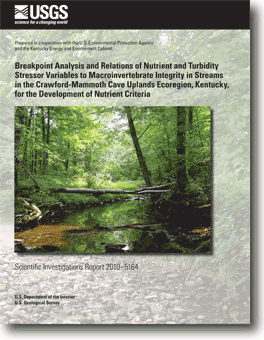Scientific Investigations Report 2010–5164
ABSTRACT
To assist Kentucky in refining numeric nutrient criteria in the Pennyroyal Bioregion, the U.S. Geological Survey and the Kentucky Division of Water collected and analyzed water chemistry, turbidity, and biological-community data from 22 streams throughout the Crawford-Mammoth Cave Upland ecoregion (U.S. Environmental Protection Agency Level IV Ecoregion, 71a) within the Pennyroyal Bioregion from September 2007 to May 2008. Statistically significant and ecologically relevant relations among the stressor (total phosphorus, total nitrogen, and turbidity) variables and response (macroinvertebrate-community attributes) variables and the breakpoint values of biological-community attributes and metrics in response to changes in stressor variables were determined. |
Posted September 2010 For additional information contact: Part or all of this report is presented in Portable Document Format (PDF); the latest version of Adobe Reader or similar software is required to view it. Download the latest version of Adobe Reader, free of charge. |
Crain, A.S. and Caskey, B.J., 2010, Breakpoint analysis and relations of nutrient and turbidity stressor variables to macroinvertebrate integrity in streams in the Crawford-Mammoth Cave Uplands Ecoregion, Kentucky, for the development of nutrient criteria: U.S. Geological Survey Scientific Investigations Report 2010—5164, 29 p
Abstract
Introduction
Purpose and Scope
Description of the Study Area
Study Design and Methods
Site Selection
Sample Collection and Processing Methods
Nutrients and Turbidity
Macroinvertebrate Communities
Data Analysis
Distribution of the Nutrient and Turbidity Variables
Relations between the Nutrient and Turbidity Stressor Variables
Macroinvertebrate Community Attributes, Relations Between Stressor and Response Variables, and Nutrient Breakpoints using Macroinvertebrate Attributes
Summary of Macroinvertebrate-Community Attributes
Distribution of the Macroinvertebrate Communities and Their Relations to Nutrient Stressor Variables
Macroinvertebrate-Community Breakpoints of the Nutrient Stressor Variables and Implications for Developing Nutrient Criteria in the Crawford-Mammoth Cave Uplands Ecoregion
Macroinvertebrate Communities and the Comparison of Trophic Classification for Nutrient Concentrations and Turbidity Values
Summary and Conclusions
References Cited
Appendixes